When it comes to establishing what the biggest problem with the state of the art of pitching is, there's a lot to choose from.
One problem is that most of the studies and research that I discuss in The Science Behind The Epidemic are ignored by the other prominent names in pitching mechanics. It's as if important studies like Dr. Cynthia LaBella's study of the incidence of pain in youth pitchers don't exist.
I'm not sure why people are doing their own research when there is so much interesting, directly relevant research already out there, and it makes me nervous whenever I hear of people doing new studies that don't reference the ones that have already been done.
Is the issue that they aren't happy with what the existing research is saying?
However, people ignoring the research is far from the biggest problem with the state of the art of pitching.
The (Biggest) Problem with Pitching
I believe the biggest problem with pitching is the idea that...
- You can only do good work if you do it in a biomechanics lab.
- Anything that comes out of a biomechanics lab is good.
There are a number of huge problems with relying on biomechanics labs, and I discuss each below.
The S Word
As I discuss at length in my piece that explains my point of view, too much pitching instruction is "should" based.
It's based on telling you what you "should" do.
Unfortunately, in far too many cases, what people are being told they should do is often quite different than what the best pitchers (actually) do.
Or, what has been proven to reduce the risk of elbow and/or shoulder pain.
I came across the best example of the current "should" culture, and its problems, at the very start of my process of trying to understand the Tommy John surgery and Thoracic Outlet Syndrome epidemic.
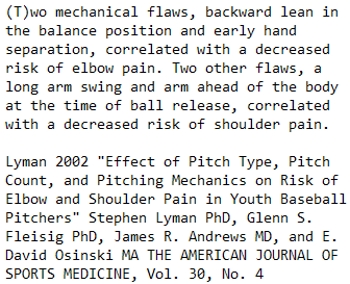
If Something REDUCES the Risk of Pain...
How do you label as flaws things that reduce the risk of elbow and/or shoulder pain?
The only thing that makes sense is that the authors of that paper, instead of going where the data led them, had a preconceived model of pitching mechanics in mind. As a result, that led them to label ANY deviations from that preconceived model -- even deviations that REDUCED the risk of elbow and shoulder problems -- as flaws.
How do you get that point?
I believe one answer to that question is, "By investing a ton of money in an immobile biomechanics lab."
The Limits of Biomechanics Labs
The problem with the current biomechanics labs based culture is that, if you can't get Mariano Rivera, Justin Verlander, or David Price to come to your biomechanics lab, then they won't be part of your model.
I say this based on what I see being produced by organizations with biomechanics labs.
Mayo Clinic
The Mayo Clinic's "Mechanics of a Safer Fastball" is easily the worst-named piece in the world of pitching mechanics.

Mayo Clinic Power Position
The Power Position that the Mayo Clinic is selling as safer is, in truth, incredibly dangerous and is one of the main drivers of the Tommy John surgery and Thoracic Outlet Syndrome epidemic.
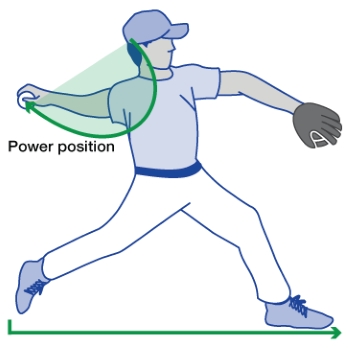
Mayo Clinic Power Position
The power position that the Mayo Clinic is selling bears no resemblance to what you see in the arm actions of dominant and durable pitchers like Justin Verlander.

Justin Verlander
What it does resemble is the mechanics of frequently-injured pitchers like Henderson Alvarez.

Henderson Alvarez
How is that possible? I don't know for sure.
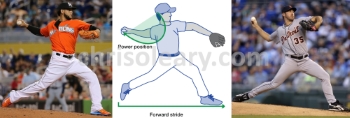
Alvarez, Mayo Clinic Power Position, and Verlander
But I suspect at least part of the problem is that the Mayo Clinic has little to no idea what the best pitchers actually do, a sadly but increasingly common problem that is created by an exclusive focus on pitchers who come through an organization's biomechanics lab rather than the entire population of pitchers.
ASMI
Similarly, in the latest guidelines I've seen, ASMI says pitchers should exhibit 32 to 76 degrees of external rotation at stride foot contact.
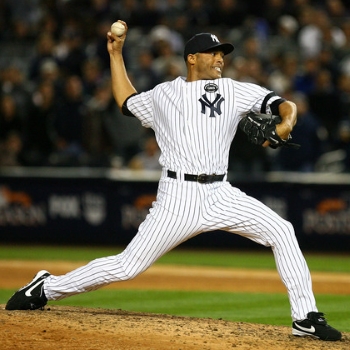
Mariano Rivera
That's weird because, as I point out and discuss at length in my comments on ASMI's pitching mechanics model, Mariano Rivera exhibits 90 degrees of external rotation at stride foot contact in every still photo and video clip I possess.
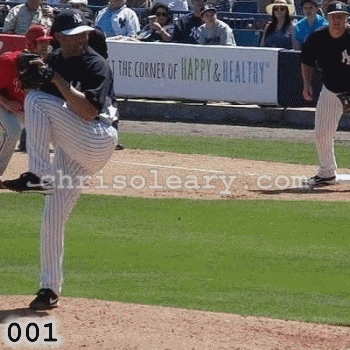
Mariano Rivera
My fear is that ASMI research, and the guidelines they are producing, is limited by the characteristics of the pitchers who come into their lab and is becoming increasingly disconnected from reality.
And, more importantly, history.
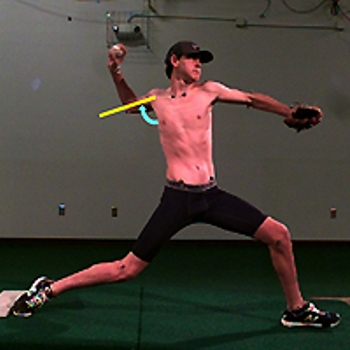
ASMI's Example of Proper Pitching Mechanics
What brought this to mind was the picture above, a picture that purports to show proper pitching mechanics.
The problem is there is precious little difference between the pitching mechanics of that pitcher -- who would seem to represent ASMI's model of proper pitching mechanics -- and Hunter Harvey, a pitcher who has had problems staying healthy.
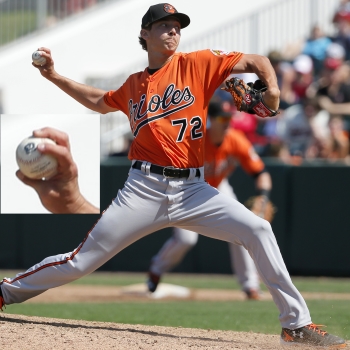
Hunter Harvey
I don't know anything about the pitcher that ASMI used, but I suspect that the reason ASMI has video of him is because he came to them for an evaluation of his pitching mechanics.
In an effort to diagnose what I suspect were elbow problems.
I would hope it's obvious that basing your model on flawed pitching mechanics is going to produce a model that says that flawed pitching mechanics are good pitching mechanics.
My general concern with ASMI's approach is that, because they seem to base many of their guidelines on what they see in the mechanics of the pitchers who come into their lab, I believe their numbers will increasingly diverge from what dominant and durable pitchers (actually) do.
I fear that ASMI's guidelines will reflect the general degradation of pitching mechanics.
That will then create a negative feedback loop where, because ASMI's guidelines are based on what they are seeing...
We have data from testing of more than 2,000 pitchers at ASMI, including an elite database of more than 100 professional pitchers who throw greater than 87 miles per hour during testing...
...their guidelines will increasingly diverge from what dominant and durable pitchers do as the general population of pitchers, and the pitchers who pass through their lab, diverges from what dominant and durable pitchers do.
Or did.
Driveline
What's missing from Driveline's methodology?
- Long-term validation of their methods.
- A sense of history. A connection with reality.
Yes, their ideas may help boost velocity. But are they proven? Safe?
I don't see that connection being made here...
For instance, the elbow spiral Driveline advocates will create what I call the Inverted L or the Inverted V.
I don't doubt that what Driveline, Tom House, BaseballThinkTank and others teach works. My concern is it's very limited in terms of real science. And there's basically no connection with the history of the game.
What can't be digitized with their tools can't be incorporated into their model.
As with Davis (2009), what is utterly lacking is any long-term, longitudinal study of the health consequences of what is being taught, not just whether it improves pitchers' velocity or not.
My Approach
My approach is to build my pitching mechanics model on what the best pitchers in the world -- major league pitchers -- actually do.
Doing that means investing in portable high-speed video equipment that can be taken into minor and major league stadiums. I also invest considerable time and money in traveling across the country to see the best pitchers and hitters play in games.
For example, by mid-2016 it became obvious that Justin Verlander had returned to his prior form. As a result, I spent much of my summer going to see him pitch in 8 games, traveling to Florida, Kansas City, Detroit, and Chicago in the process.

Justin Verlander 2014
As a result, I came away from this summer with hundreds of high speed video clips and thousands of still pictures of Justin Verlander in prime condition. I am now in the process of mining those clips and pictures for the best examples of Justin Verlander at his best for a new ebook that will be part of my Dominant & Durable series.
In general, my goal isn't to invent anything new; to come up with new ways of moving and generating velocity.
Rather, I'm just a student of the game.
A student of the best hitters and pitchers to have ever played the game.
In the case of pitchers, and because of the injury thing, there is an added layer of study beyond just performance.
Longevity.
I want to understand how pitchers who were and are both dominant and durable moved and stayed healthy; what their secrets are, and the best way to teach those secrets to my pitchers.